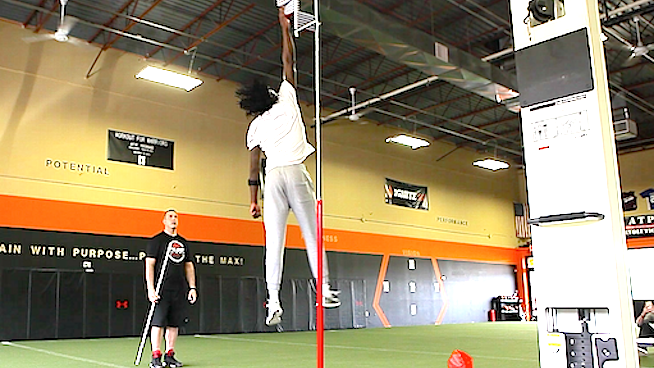An 8-Week Training Program for a Higher Vertical Jump
The Vertical Jump is a benchmark test to help determine athleticism and power. It’s also a tool used to help select and recruit athletes. The ability to jump vertically is critical to most sports, so it’s worth spending time to improve it. This article covers several essential exercises for training your Vertical Jump, and it presents an eight-week program that you can follow to increase it.
Several qualities are important for a successful Vertical Jump. To have a good vertical, an athlete first has to have a foundation of strength. There are two big reasons for this. One, power is the ability to exert force quickly, so the athlete needs to enhance his or her ability to exert force. Two, most power exercises like plyometrics are more effective for stronger athletes. The second quality is the ability to apply your strength quickly. In other words, being strong is good, but you also have to know how to use your strength. As we’ll discuss, a lot of exercises help you to develop this. The third quality is good technique. This is a skill, meaning it must be practiced to be perfected. With that in mind, the list below shows exercises you can use to develop the qualities important for a successful jump.
- Strength: Squats, hip extension exercises, Lunges/Step-Ups, even upper-body work
- Applying strength quickly: Pulls, plyometrics, Medicine Ball Throws
- Technique: Squats, plyometrics

Some of these exercises may seem surprising. Here is why I focus on them:
- Pulls: These teach the fast application of strength. They are not nearly as complicated as Power Cleans and Power Snatches.
- Squats: This essential movement pattern is very similar to jumping. Strengthening these muscles is an important prerequisite to developing power for the Jump.
- Hip extension exercises: The glutes and hamstrings have to be strengthened, not only to help with the Jump but also to allow for a safe landing.
- Lunges and Step-Ups: These are included in the program so that you can focus on each leg. This helps to ensure that one leg doesn’t lag behind the other and negatively impact your performance.
- Plyometrics: Plyometrics are critical because they teach the application of weight room strength and power. This program includes the following types of plyometrics:
- Hops: These help to develop the ankles and shins.
- Squat Jumps: Performing a Vertical Jump, but only after holding the bottom squat position.
- Counter-movement Jumps: The Vertical Jump exercise. It makes sense to practice this in training before attempting it in testing.
- Box Jumps: The focus is on jumping for height in this program. This is where you jump up to a high box.
- Upper-body work: The upper body (the arm swing) contributes to Vertical Jump performance, so it’s important to do some upper-body work when focusing on the Vertical Jump.
- Medicine Ball Throws: The Medicine Ball Throw exercises in this program either develop the jumping motion (like squatting and then throwing the ball behind you) or the upper body to assist with the jump.
Although they’re not included in this program, Kettlebell Swing variations are also highly effective for helping you jump higher.
Now that we’ve covered the types of exercises, what follows is the eight-week program. It is broken into two blocks of training, each four weeks long. If you aren’t able to commit to a full eight-week plan, here’s a one-week vertical jump program that I created that features many of the elements described above.
Weeks One through Four
This part of the program develops your foundation. The focus is on building a muscle and technique base prior to engaging in the more intense training in the latter four weeks of the program. In this part of the program, you will be training four days a week. The program is divided into two lower-body days and two upper-body days, complete with weights, plyos, and medicine ball work.
Below is how each workout in the first four weeks should be organized. For each exercise, we show sets x repetitions x the percentage of maximum. When a percentage of maximum is not shown, you should pick a weight that barely allows you to get that number of repetitions. Note that the sets, repetitions, and weights shown are for the first week of training.
Day 1
Strength
- Clean Pulls: 3×3-6@70% of Power Clean
- Back Squats: 3×8-12@70%
- Lunges: 3×8-12 each leg
- Romanian Deadlifts: 3×8-12
- Reverse Hyperextensions: 3×8-12
Plyos
- Squat Jumps: 10x
- Ankle Hops: 3×10 meters
Day 2
Strength
- Bench Press: 3×8-12×70%
- Bent-Over Rows: 3×8-12
- Standing Military Press: 3×8-12
Medicine Ball Exercises
- Backwards toss: 10x
- Forwards toss: 10x
Day 3
Off
Day 4
Strength
- Snatch Pulls: 3×3-6@70%
- Front Squats: 3×8-12@70%
- Step-Ups: 3×12-15 each leg
- Good Mornings: 3×8-12
- Single-Leg RDL: 3×8-12 each leg
Plyos
- Counter-movement jumps, stick the landing: 10x
- Split cycle jumps: 10x each leg
Day 5
Strength
- Incline Press: 3×8-12@70%
- Single-Arm Dumbbell Rows: 3×8-12 for each arm
- Standing Kettlebell Press: 3×8-12 for each arm
Medicine Ball Exercises
- Chest pass: 10x
- Side toss: 5x each side
As the program progresses, the sets, repetitions, and intensities change to what is shown below. Note that plyos are not in the table as their volume should remain constant throughout this part of the program:
| Exercise Type | Week One | Week Two | Week Three | Week Four |
| Pulls | 3×3-6@70% | 3×3-6@75% | 3×3-6@80% | 3×3-6@70% |
| Squats | 3×8-12@70% | 3×8-12@75% | 3×8-12@80% | 3×12-15@70% |
| Lunges/Step Ups | 3×8-12 | 3×6-10 | 3×4-8 | 3×12-15 |
| Hip extensions | 3×8-12 | 3×6-10 | 3×4-8 | 3×12-15 |
| Presses | 3×8-12@70% | 3×8-12@75% | 3×8-12@80% | 3×12-15@70% |
| Rows | 3×8-12 | 3×6-10 | 3×4-8 | 3×12-15 |
| Shoulder presses | 3×8-12 | 3×6-10 | 3×4-8 | 3×12-15 |
Weeks Five through Eight
This is the more intense phase of the vertical training program. This program takes advantage of complex training—i.e., the combination of strength exercises with power exercises. The idea is that the strength exercise maximally recruits the nervous system, and then the power exercise takes advantage of that recruitment. The strength training intensities get pretty high during this phase. The first week is listed below.
Day 1
- Deadlift + Clean Pull: 3×4-8+2-3@80% of Power Clean
- Back Squats + Squat Jumps: 3×4-8@80%+10 Jumps
- Lunges + Split cycle jumps: 3×4-8+5 Jumps each leg
- Romanian Deadlifts: 3×6-10
- Reverse hyperextensions: 3×6-10
Day 2
- Bench Press + Medicine Ball Chest Pass: 3×4-8@80% + 10 throws
- Bent-Over Rows + Medicine Ball Backwards Toss: 3×4-8 + 10 throws
- Standing Military Press + Medicine Ball Front Toss: 3×4-8 + 10 throws
Day 3
Off
Day 4
- Snatch-Grip Deadlifts + Snatch Pulls: 3×4-8 + 3-6@80% of Power Snatch
- Split Squats + Split Jumps: 3×4-8@40% of Back Squat + 5 Jumps, each leg
- Step-Ups + Box Jumps (to a height): 3×4-8 each leg + 10 Jumps
- Good Mornings: 3×6-10
- Single-Leg RDL: 3×6-10 each leg
Day 5
- Incline Press + Lying Medicine Ball Chest Pass: 3×4-8@80% + 10 throws
- Single-Arm Dumbbell Rows + Medicine Ball Side Toss: 3×4-8 + 5 throws each arm/side
- Standing Kettlebell Press: 3×4-8 each arm
The intensities, sets, and repetitions shown were for week one. As the program progresses, they change, as shown in the table below. Make a note that plyos are not included in this table as the volume remains constant throughout the program:
| Exercise Type | Week One | Week Two | Week Three | Week Four |
| Deadlifts + Pulls | 3×4-8+2-3@80% | 3×3-6+2-3@85% | 3×2-4+2-3@90% | 3×6-10+3-6@70% |
| Back Squats | 3×4-8@80% | 3×3-6@85% | 3×2-4@90% | 3×6-10@70% |
| Split squats | 3×4-8@40% | 3×3-6@45% | 3×2-4@50% | 3×6-10@30% |
| Lunges/Step Ups | 3×4-8 | 3×3-6 | 3×2-4 | 3×6-10 |
| Hip extensions | 3×6-10 | 3×4-8 | 3×3-6 | 3×12-15 |
| Presses | 3×4-8@80% | 3×3-6@85% | 3×2-4@90% | 3×6-10@70% |
| Rows | 3×4-8 | 3×3-6 | 3×2-4 | 3×6-10 |
| Shoulder presses | 3×4-8 | 3×3-6 | 3×2-4 | 3×6-10 |
RELATED:
- 4 Proven Strategies to Increase Your Vertical Jump for Basketball
- How to Dunk a Basketball
- Drills For Perfecting Your Jump Shot
- 3 Tips to Instantly Increase Your Vertical Jump
- How to Improve Your Vertical Jump Without Jumping
RECOMMENDED FOR YOU
MOST POPULAR
An 8-Week Training Program for a Higher Vertical Jump
The Vertical Jump is a benchmark test to help determine athleticism and power. It’s also a tool used to help select and recruit athletes. The ability to jump vertically is critical to most sports, so it’s worth spending time to improve it. This article covers several essential exercises for training your Vertical Jump, and it presents an eight-week program that you can follow to increase it.
Several qualities are important for a successful Vertical Jump. To have a good vertical, an athlete first has to have a foundation of strength. There are two big reasons for this. One, power is the ability to exert force quickly, so the athlete needs to enhance his or her ability to exert force. Two, most power exercises like plyometrics are more effective for stronger athletes. The second quality is the ability to apply your strength quickly. In other words, being strong is good, but you also have to know how to use your strength. As we’ll discuss, a lot of exercises help you to develop this. The third quality is good technique. This is a skill, meaning it must be practiced to be perfected. With that in mind, the list below shows exercises you can use to develop the qualities important for a successful jump.
- Strength: Squats, hip extension exercises, Lunges/Step-Ups, even upper-body work
- Applying strength quickly: Pulls, plyometrics, Medicine Ball Throws
- Technique: Squats, plyometrics

Some of these exercises may seem surprising. Here is why I focus on them:
- Pulls: These teach the fast application of strength. They are not nearly as complicated as Power Cleans and Power Snatches.
- Squats: This essential movement pattern is very similar to jumping. Strengthening these muscles is an important prerequisite to developing power for the Jump.
- Hip extension exercises: The glutes and hamstrings have to be strengthened, not only to help with the Jump but also to allow for a safe landing.
- Lunges and Step-Ups: These are included in the program so that you can focus on each leg. This helps to ensure that one leg doesn’t lag behind the other and negatively impact your performance.
- Plyometrics: Plyometrics are critical because they teach the application of weight room strength and power. This program includes the following types of plyometrics:
- Hops: These help to develop the ankles and shins.
- Squat Jumps: Performing a Vertical Jump, but only after holding the bottom squat position.
- Counter-movement Jumps: The Vertical Jump exercise. It makes sense to practice this in training before attempting it in testing.
- Box Jumps: The focus is on jumping for height in this program. This is where you jump up to a high box.
- Upper-body work: The upper body (the arm swing) contributes to Vertical Jump performance, so it’s important to do some upper-body work when focusing on the Vertical Jump.
- Medicine Ball Throws: The Medicine Ball Throw exercises in this program either develop the jumping motion (like squatting and then throwing the ball behind you) or the upper body to assist with the jump.
Although they’re not included in this program, Kettlebell Swing variations are also highly effective for helping you jump higher.
Now that we’ve covered the types of exercises, what follows is the eight-week program. It is broken into two blocks of training, each four weeks long. If you aren’t able to commit to a full eight-week plan, here’s a one-week vertical jump program that I created that features many of the elements described above.
Weeks One through Four
This part of the program develops your foundation. The focus is on building a muscle and technique base prior to engaging in the more intense training in the latter four weeks of the program. In this part of the program, you will be training four days a week. The program is divided into two lower-body days and two upper-body days, complete with weights, plyos, and medicine ball work.
Below is how each workout in the first four weeks should be organized. For each exercise, we show sets x repetitions x the percentage of maximum. When a percentage of maximum is not shown, you should pick a weight that barely allows you to get that number of repetitions. Note that the sets, repetitions, and weights shown are for the first week of training.
Day 1
Strength
- Clean Pulls: 3×3-6@70% of Power Clean
- Back Squats: 3×8-12@70%
- Lunges: 3×8-12 each leg
- Romanian Deadlifts: 3×8-12
- Reverse Hyperextensions: 3×8-12
Plyos
- Squat Jumps: 10x
- Ankle Hops: 3×10 meters
Day 2
Strength
- Bench Press: 3×8-12×70%
- Bent-Over Rows: 3×8-12
- Standing Military Press: 3×8-12
Medicine Ball Exercises
- Backwards toss: 10x
- Forwards toss: 10x
Day 3
Off
Day 4
Strength
- Snatch Pulls: 3×3-6@70%
- Front Squats: 3×8-12@70%
- Step-Ups: 3×12-15 each leg
- Good Mornings: 3×8-12
- Single-Leg RDL: 3×8-12 each leg
Plyos
- Counter-movement jumps, stick the landing: 10x
- Split cycle jumps: 10x each leg
Day 5
Strength
- Incline Press: 3×8-12@70%
- Single-Arm Dumbbell Rows: 3×8-12 for each arm
- Standing Kettlebell Press: 3×8-12 for each arm
Medicine Ball Exercises
- Chest pass: 10x
- Side toss: 5x each side
As the program progresses, the sets, repetitions, and intensities change to what is shown below. Note that plyos are not in the table as their volume should remain constant throughout this part of the program:
| Exercise Type | Week One | Week Two | Week Three | Week Four |
| Pulls | 3×3-6@70% | 3×3-6@75% | 3×3-6@80% | 3×3-6@70% |
| Squats | 3×8-12@70% | 3×8-12@75% | 3×8-12@80% | 3×12-15@70% |
| Lunges/Step Ups | 3×8-12 | 3×6-10 | 3×4-8 | 3×12-15 |
| Hip extensions | 3×8-12 | 3×6-10 | 3×4-8 | 3×12-15 |
| Presses | 3×8-12@70% | 3×8-12@75% | 3×8-12@80% | 3×12-15@70% |
| Rows | 3×8-12 | 3×6-10 | 3×4-8 | 3×12-15 |
| Shoulder presses | 3×8-12 | 3×6-10 | 3×4-8 | 3×12-15 |
Weeks Five through Eight
This is the more intense phase of the vertical training program. This program takes advantage of complex training—i.e., the combination of strength exercises with power exercises. The idea is that the strength exercise maximally recruits the nervous system, and then the power exercise takes advantage of that recruitment. The strength training intensities get pretty high during this phase. The first week is listed below.
Day 1
- Deadlift + Clean Pull: 3×4-8+2-3@80% of Power Clean
- Back Squats + Squat Jumps: 3×4-8@80%+10 Jumps
- Lunges + Split cycle jumps: 3×4-8+5 Jumps each leg
- Romanian Deadlifts: 3×6-10
- Reverse hyperextensions: 3×6-10
Day 2
- Bench Press + Medicine Ball Chest Pass: 3×4-8@80% + 10 throws
- Bent-Over Rows + Medicine Ball Backwards Toss: 3×4-8 + 10 throws
- Standing Military Press + Medicine Ball Front Toss: 3×4-8 + 10 throws
Day 3
Off
Day 4
- Snatch-Grip Deadlifts + Snatch Pulls: 3×4-8 + 3-6@80% of Power Snatch
- Split Squats + Split Jumps: 3×4-8@40% of Back Squat + 5 Jumps, each leg
- Step-Ups + Box Jumps (to a height): 3×4-8 each leg + 10 Jumps
- Good Mornings: 3×6-10
- Single-Leg RDL: 3×6-10 each leg
Day 5
- Incline Press + Lying Medicine Ball Chest Pass: 3×4-8@80% + 10 throws
- Single-Arm Dumbbell Rows + Medicine Ball Side Toss: 3×4-8 + 5 throws each arm/side
- Standing Kettlebell Press: 3×4-8 each arm
The intensities, sets, and repetitions shown were for week one. As the program progresses, they change, as shown in the table below. Make a note that plyos are not included in this table as the volume remains constant throughout the program:
| Exercise Type | Week One | Week Two | Week Three | Week Four |
| Deadlifts + Pulls | 3×4-8+2-3@80% | 3×3-6+2-3@85% | 3×2-4+2-3@90% | 3×6-10+3-6@70% |
| Back Squats | 3×4-8@80% | 3×3-6@85% | 3×2-4@90% | 3×6-10@70% |
| Split squats | 3×4-8@40% | 3×3-6@45% | 3×2-4@50% | 3×6-10@30% |
| Lunges/Step Ups | 3×4-8 | 3×3-6 | 3×2-4 | 3×6-10 |
| Hip extensions | 3×6-10 | 3×4-8 | 3×3-6 | 3×12-15 |
| Presses | 3×4-8@80% | 3×3-6@85% | 3×2-4@90% | 3×6-10@70% |
| Rows | 3×4-8 | 3×3-6 | 3×2-4 | 3×6-10 |
| Shoulder presses | 3×4-8 | 3×3-6 | 3×2-4 | 3×6-10 |
RELATED:
- 4 Proven Strategies to Increase Your Vertical Jump for Basketball
- How to Dunk a Basketball
- Drills For Perfecting Your Jump Shot
- 3 Tips to Instantly Increase Your Vertical Jump
- How to Improve Your Vertical Jump Without Jumping










